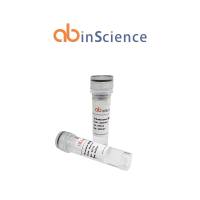Transcription of cRNA probe
互联网
Transcription of cRNA probe
Reagents/Solutions
DNA (PCR or plasmid) with bacteriophage RNA polymerase promoter in suitable orientation (see note 1 ) ~1µg/µl in TE buffer
10mM MgCl2
5x Transcription Buffer
0.2M Tris - HCl pH 7.5
50mM NaCl
10mM spermidine
30mM MgCl2
0.1M dithiothreitol
Bacteriophage RNA polymerase (50U/µl)
RNase Inhibitor
NTP mix (10mM ATP, CTP, GTP, 6.5mM UTP, 3.5mM digoxigenin or fluorescein UTP)
10% sodium dodecyl sulphate (SDS).
2-mercaptoethanol
Protocol
Place 5µl template DNA in a clean eppendorf tube (see note 2 ). Place tube on ice.
Add in the following order:
1µl 10mM MgCl2
14µl H2 O
5µl 0.1M dithiotreitol
5µl labelling NTP mix
10µl 5x reaction buffer
5µl RNase inhibitor (200U)
5µl Bacteriophage RNA polymerase (250U)
Mix by pipetting up and down or gently flicking the tube. It is best to avoid vortexing at this stage.
Incubate at 37 to 40℃for 2 hours.
Analyse a small sample by non-denaturing agarose gel electrophoresis and visualise bands by ethidium bromide staining and UV illumination (see note 3 ).
Stop transcription reaction by addition of 5µl SDS, 2µl 2-mercaptoethanol and incubation at 80℃for 5 minutes.
Store probe at -20℃until required. Multiple rounds of thawing / freezing do not appear to significantly reduce the activity of the probe.
Suitable plasmid DNA may be obtained from cloning your desired fragment into the multiple cloning site of an appropriate vector e.g. Stratagene's pBluescript or Promega's (or, if you are not in europe Promega ) pGEM4Z. Plasmid preparations must be very carefully extracted with phenol / chloroform to remove the added RNase A. They should also be fully linearized. Select a restriction endonuclease which will cut in the multiple cloning site between the 5' end of the insert and the adjacent bacteriophage RNA polymerase promoter. To transcribe the antisense RNA required for a probe in Northern blots, use RNA polymerase which is active on the promoter adjacent to the 3' end of your insert.
Suitable PCR DNA may be obtained from a standard 100µl reaction where the 3' (downstream) primer contains (at its 5' end) the SP6 promoter sequence (5' ...TAC AAG GAA TTG GAT TTA GGT GAC ACT ATA GAG A - YOUR GENE SPECIFIC SEQUENCE... 3') or the T7 promoter sequence (5' ...GGG GCC AAG CAC TAA TAC GAC TCA CTA TAG GG - YOUR GENE SPECIFIC SEQUENCE... 3'). Phenol / chloroform extract, isopropanol or ethanol precipitate and resuspend in 5µl TE buffer. Inclusion of the bacteriophage RNA polymerase promoter sequence regions also provides a convenient target for non - radioactive PCR sequencing of your amplified product using a 5' digoxigenin or fluorescein labelled SP6 or T7 primer.
A stock of eppendorf tubes which are sterile for tissue culture purposes and clean for PCR and RNA applications may be simply obtained. Purchase a bag of tubes which are supplied in a fully airtight bag (e.g. 'real' Eppendorfs ). Without opening or tearing the bag carefully close all of the lids. Tedious but effective.
Keep one minigel type apparatus solely for use with RNA applications. Remove RNases: I find that a 1 - 2 hour soak in 2% Micro (or equivalent) followed by a rinse with H2 O suffices for this. For the gel I find it simplest to include the ethidium bromide in both gel and (TAE) buffer. Digoxigenin and fluorescein - UTP reduces transcription efficiency, you won't get as much RNA as you might hope, but you should still have more than enough. Furthermore, the digoxigenin or fluorescein groups incorporated into the transcript significantly reduce its electrophoreitic mobility. In many cases the single stranded RNA product may only just resolve from the double stranded PCR DNA template.
Note 4. This protocol is an adaption of that described by Holtke and Kessler Nucleic Acids Research (1990) Vol. 18 pp. 5843-5851. Digoxigenin is trademarked by Boehringer Mannheim .









